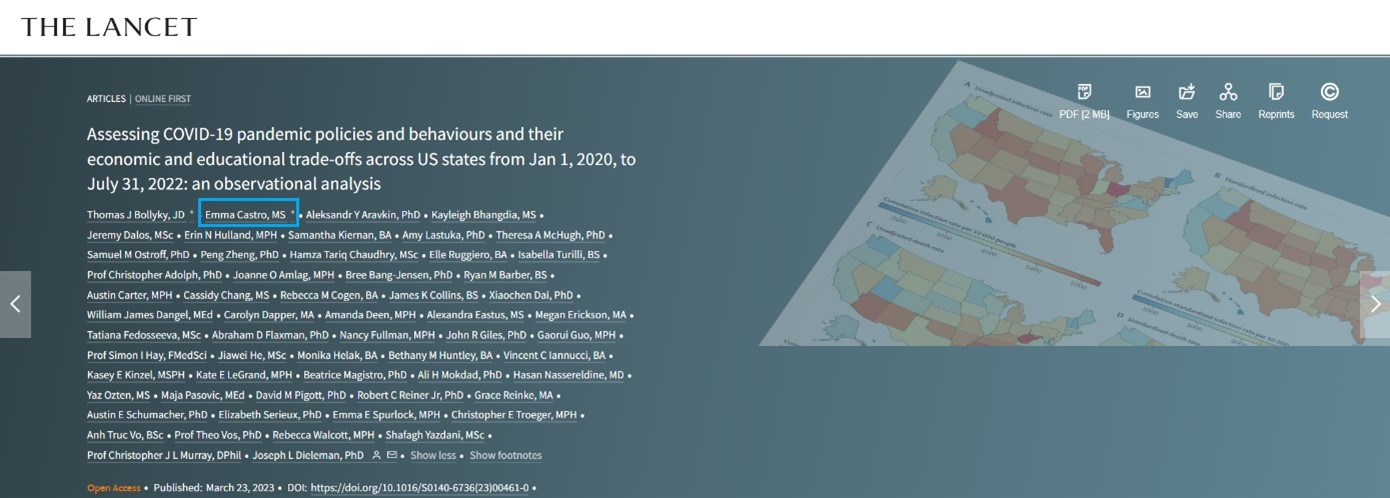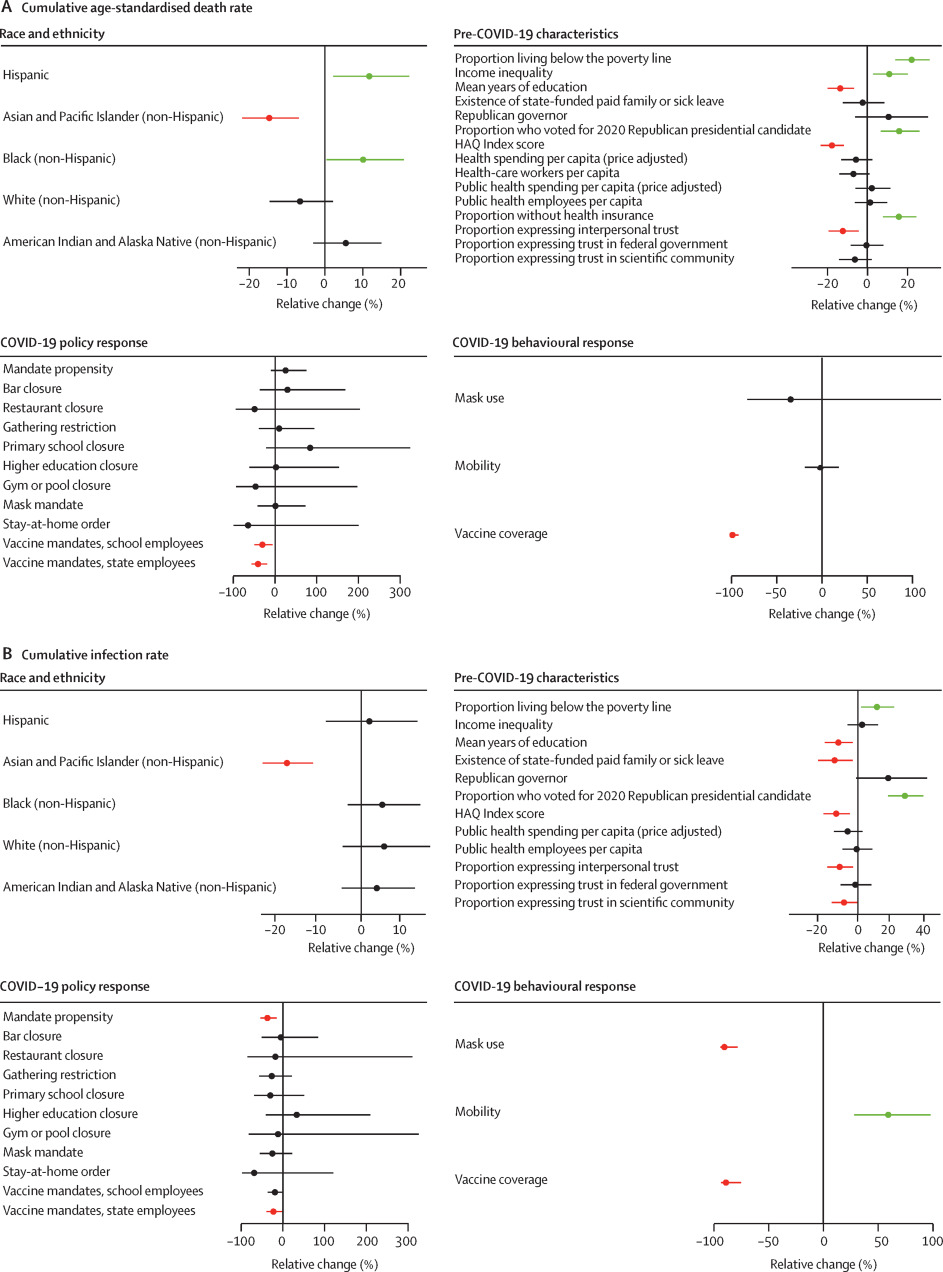What’s it like to be a co-lead author for the first time?
Published March 29, 2023
One of the greatest accomplishments for a budding researcher is to get published in an academic journal. An even more thrilling prospect is seeing your name listed as a first, or lead, author. Emma Castro, who juggles her responsibilities as a PhD student in Global Health Metrics at the University of Washington with her position as a full-time researcher at IHME, discussed her experience being a co-lead author for the first time.
“It’s still a little surreal that my first first-author paper was published in The Lancet, one of the highest-impact journals in our field, and referenced by over 500 news articles, radio, and TV programs,” Castro said. She was tapped to co-lead the paper, a US state-by-state analysis of the impacts of COVID-19, because she had previously worked on the team that produced IHME’s weekly COVID-19 forecasts throughout much of the pandemic.

Screenshot of the author list in The Lancet. Castro appears second with an asterisk, indicating that she and Thomas Bollyky were co-lead authors.
Castro led the paper along with co-lead author Thomas Bollyky, Director of the Global Health program at the Council on Foreign Relations. Castro conducted the analysis, working closely with a team of three IHME researchers (Amy Lastuka, Jeremy Dalos, and Kayleigh Bhangdia) and drafted much of the Methods and Results sections. Bollyky brought to the team expertise in health policy, helping to interpret results through a policy lens and authoring much of the Discussion and Research in Context sections. IHME Associate Professor Joe Dieleman, as corresponding and senior author, oversaw the enterprise, lending both statistical and health policy expertise, as well as years of experience publishing in top-tier academic journals like The Lancet. “I think it made a nice balance,” Castro said. “I was really grateful for this opportunity early in my career to work with and learn from Joe and Tom.”
The study explored cross-state variation in COVID-19 infection and mortality rates, examining the relationship between COVID-19 outcomes and state-level factors falling into three broad categories: pre-pandemic state characteristics (such as health spending per person or educational attainment), pandemic era policies (such as mask mandates and business closures), and population-level behaviors (such as mask use and vaccine coverage). Castro helped select which factors to assess and how to express them in the regression analysis – particularly from the policy and behavior categories, since she was closely involved in their estimation via the COVID team’s pipeline.

The final set of factors researchers assessed and how the factors were associated with age-adjusted cumulative death rates (A) and infection rates (B), as shown in Figure 3 of the publication. Graphs show the relative change in cumulative age-adjusted deaths or infections per person that were associated with race and ethnicity (proportions of state population), pre-COVID-19 state characteristics, COVID-19 policy responses, and COVID-19 behavioral responses. For continuous pre-COVID-19 state characteristics, the reported relative change is that associated with a standard deviation increase from the national mean and age-standardized cumulative death rates. For continuous COVID-19 policy measures, the relative change is that associated with a state never having implemented a mandate versus implementing for the entire study period. Error bars are 95% confidence intervals that account for uncertainty in death or infection data as well as modeling uncertainty. Statistical significance at the 95% confidence interval level is indicated by green bars (significant increase) or red bars (significant decrease). Full caption available in The Lancet.
As a co-lead author, Castro played a much larger role for this paper compared to other IHME studies she’s collaborated on in the past. “IHME has a very inclusive policy when it comes to authorship, which is wonderful,” she said. “But, because of that, I found myself craving more involvement and visibility into the publication process – from conceptualization to analysis, writing, journal submission, peer review, and through to publication. One of the first papers I collaborated on after joining IHME was the future health scenarios paper published in 2020, which was exciting given the impact that paper made, but I contributed in a much smaller way. I conducted an analysis evaluating the accuracy of the United Nations’ long-range population forecasts that ultimately amounted to a handful of pages in the appendix.” A few years later, she was ready to take on a larger role.
One tip she suggests for future authors? Staying organized. Castro said being able to easily find earlier versions of estimates, analytic code, and associated documentation was extremely beneficial. This became especially important during the peer-review process. Even after publication, Castro said she frequently pulled data in preparation for media interviews.
Above all else, Castro emphasized that the US COVID paper was a team effort. “It was so wonderful to work with and benefit from the expertise of fellow IHME researchers, data librarians, the Scientific Publications team, and our fabulous Communications team,” she said.
After publication
Following the paper’s official release on March 23, Castro printed a copy of the paper to keep as a memento of the nearly yearlong process it took from conceptualization to publication. Seeing the paper in print helped her gain a fuller appreciation of the accomplishment and the enormous breadth of the paper itself.
She was surprised how many journalists took the time to read it carefully, like the reporters from the Las Vegas Review-Journal, The Baltimore Sun, and KUNM’s Public Health New Mexico, which were some of the local media outlets to whom Castro gave interviews. “Talking to the journalists and hearing how their lived experience of the pandemic matched up with what we saw in the data was pretty interesting,” Castro observed. “They all wanted to know about their own state, and talking through that helped cement our analysis for me and understand how it all fit together on a state-by-state level.”
With this paper’s publication in the rear window, Castro hopes to continue pursuing research related to COVID-19 as part of her PhD thesis, planning to leverage mobile phone GPS data to explore compliance with COVID-19 mandates. She feels this experience has better prepared her to complete her degree.
“I’m really grateful to have had the opportunity to be a co-lead author on this important paper,” said Castro. “I try to resist imposter syndrome. I know that I was included on this project because I am capable.”
